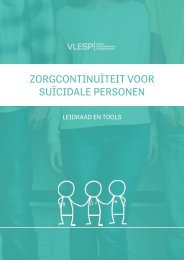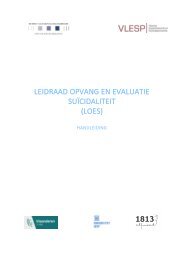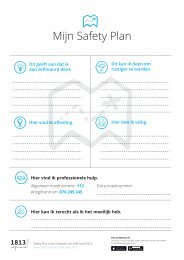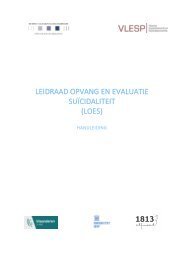IPEO Handleiding
IPEO is een belangrijk Instrument voor Psychosociale Evaluatie en Opvang van volwassen suïcidepogers. Het is een semi-gestructureerd interview waarmee risicofactoren en zorgbehoeften van suïcidepogers in kaart worden gebracht. Dit instrument is in de eerste plaats bedoeld voor het ziekenhuispersoneel dat instaat voor de opvang van suïcidepogers in een algemeen ziekenhuis.
IPEO is een belangrijk Instrument voor Psychosociale Evaluatie en Opvang van volwassen suïcidepogers. Het is een semi-gestructureerd interview waarmee risicofactoren en zorgbehoeften van suïcidepogers in kaart worden gebracht. Dit instrument is in de eerste plaats bedoeld voor het ziekenhuispersoneel dat instaat voor de opvang van suïcidepogers in een algemeen ziekenhuis.
- No tags were found...
You also want an ePaper? Increase the reach of your titles
YUMPU automatically turns print PDFs into web optimized ePapers that Google loves.
Referenties<br />
1. Kapur, N., House, A., Dodgson, K., May, C., & Creed, F. (2002). Effect of general hospital management on repeat<br />
episodes of deliberate self-poisoning: cohort study. British Medical Journal, 325, 866-867.<br />
2. Royal College of Psychiatrists. (2004). Assessment following self-harm in adults. Council Report CR122. Royal<br />
College of Psychiatrists. Londen.<br />
3. National Institute for Clinical Excellence (2004). Self-Harm, the short-term physical and psychological management<br />
and secondary prevention of self-harm in primary and secondary care. London: The British Psychological Society<br />
and The Royal College of Psychiatrists.<br />
4. Kapur, N., House, A., Creed, F., Feldman, E., Friedman, T., & Guthrie, E. (1998). Management of deliberate<br />
self-poisoning in adults in four teaching hospitals: descriptive study. British Medical Journal, 316, 831-832.<br />
5. Thomas, S.H., Bevan, L., Bhattacharyya, S., Bramble, M.G., Chew, K., Connolly, J., Dorani, B., Han,<br />
K.H., Horner, J.E., Rodgers, A., Sen, B., Tesfayohannes, B., Wynne, H., & Bateman, D.N. (1996). Presentation of<br />
poisoned patients to accident and emergency departments in the north of England. Human experimental<br />
Toxicology, 15, 466-470.<br />
6. Kerkhof, A.J.F.M. & van Heeringen, K. (2000). Richtlijnen voor de behandeling van suïcidaliteit. In: van Heeringen,<br />
K. & Kerkhof, A.J.F.M. (Eds.), Behandelingsstrategieën bij suïcidaliteit. Houten/Diegem: Bohn Stafleu Van Loghum,<br />
148-159.<br />
7. Bille-Brahe, U., Schmidtke, A., Kerkhof, A.J.F.M., De Leo, D. Lönnqvist, J., & Platt, S. (1994). Background and<br />
introduction to the study. In: A.J.F.M. Kerkhof, A. Schmidtke, U. Bille-Brahe, D. De Leo, & J. Lönnqvist (Eds.),<br />
Attempted suicidein Europe: Findings from the Multicentre study on Parasuicide by the WHO Regional Office for<br />
Europe. Leiden: DSWO Press.<br />
8. Hickey, L., Hawton, K., Fagg, J., & Weitzel, H. Deliberate self-harm patients who leave the accident and<br />
emergency department without a psychiatric assessment - A neglected population at risk of suicide. (2001).<br />
Journal of Psychosomatic Research, 50, 87-93.<br />
9. Gibb, S.J., Beautrais, A.L., & Fergusson, D.M. (2005). Mortality and further suicidal behaviour after an index<br />
suicide attempt: a 10-year study. Australian and New Zealand Journal of Psychiatry, 39, 95-100.<br />
10. Hawton, K. (2000). Sex and suicide: Gender differences in suicidal behaviour<br />
British Journal of Psychiatry, 1, 177, 484-485.<br />
11. Colman, I., Newman, S.C., Schopflocher, D., Bland, R.C., & Dyck, R.J. (2004). A multivariate study of predictors of<br />
repeat parasuicide. Acta Psychiatrica Scandinavica, 109(4), 306-312.<br />
12. Beautrais, A.L. (2001). Suicides and serious suicide attempts: two populations or one? Psychological Medicine, 31,<br />
837-845.<br />
13. Beautrais, A.L. (2003a). Subsequent mortality in medically serious suicide attempts: a 5 year follow-up. Australian<br />
and New Zealand Journal of Psychiatry, 37, 595-599.<br />
14. Beautrais, A.L. (2003b). Suicide and Serious Suicide Attempts in Youth: A Multiple-Group Comparison Study.<br />
American Journal of Psychiatry, 160, 1093-1099.<br />
15. Beautrais, A.L. (2004). Further suicidal behaviour amongst medically serious suicide attempters. Suicide and<br />
Life-Threatening Behaviour, 34, 1-11.<br />
16. Conner, K.R., Langley, J., Tomaszewski, K.J., & Conwell, Y. (2003). Injury Hospitalization and Risks for Subsequent<br />
Self-Injury and Suicide: A National Study From New Zealand. American Journal of Public Health, 93, 1128-1131.<br />
17. Kotila, L., & Lönnqvist, J. (1987). Adolescents who make suicide attempts repeatedly. Acta Psychiatrica<br />
Scandinavica, 76, 386-393.<br />
18. Bille-Brahe, U., & Jessen, G. (1994). Repeated suicidal behavior: a two-year follow-up. Crisis, 15, 77-82.<br />
19. Kreitman, N., & Foster, J. (1991). The construction and selection of predictive scales, with special reference to<br />
parasuicide. British Journal of Psychiatry, 159, 185-192.<br />
20. Kreitman, N., & Casey, P. (1988). Repetition of parasuicide: An epidemiological and clinical study. British Journal of<br />
Psychiatry, 153, 792-800.<br />
21. Wang, A., Nielsen, B., Bille-Brahe, U., Hansen, W., & Kolmos, L. (1985). Attempted suicide in Denmark. III.<br />
Assessment of repeated suicidal behaviour. Acta Psychiatrica Scandinavica, 72, 389-394.<br />
22. Buglass, D., & Horton, H. J. (1974). A scale for predicting subsequent suicidal behaviour. British Journal of<br />
Psychiatry, 124, 573-578.<br />
23. Tejedor, M.C., Diaz, A., Castillon, J.J., & Pericay, J.M. (1999). Attempted suicide: repetition and survival-findings of<br />
a follow-up study. Acta Psychiatrica Scandinavica, 100, 205-211.<br />
29
















